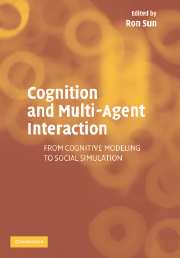1 - Prolegomena To Integrating Cognitive Modeling And Social Simulation
Published online by Cambridge University Press: 15 December 2009
Summary
INTRODUCTION
A multi-agent system (i.e., a society of agents) is a community of autonomous entities each of which perceives, decides, and acts on its own, in accordance with its own interest, but may also cooperate with others to achieve common goals and objectives. How to achieve meaningful coordination among agents in general, however, is a difficult issue and, to a very large extent, a mystery thus far (despite the fact that it has been extensively tackled).Over the years, the notions of agent and agency have occupied a major role in defining research in social and behavioral sciences, including sociology, philosophy, economics, psychology, and many other fields. The notion of agent has also invaded computer science and engineering (in Internet computing and in robotics research in particular). Computational models of agents have been developed in both artificial intelligence and cognitive science. In AI, they appear under the rubric of “intelligent agents.” In cognitive science, they are often known as “cognitive architectures,” that is, the essential structure and process of a (broadly-scoped) domain-generic computational cognitive model. They are often used for broad, cross-domain analysis of cognition and behavior (Newell, 1990; Sun, 2002). Together, these strands of research provide useful paradigms for addressing some fundamental questions concerning human nature (Newell, 1990; Anderson & Lebiere, 1998; Sun, 2002).In particular, although traditionally the main focus of research in cognitive science has been on specific components of cognition (e.g., perception, memory, learning, or language), relatively recent developments in computational modeling through cognitive architectures provide new avenues for precisely specifying a range of complex cognitive processes together intangible ways.
Information
- Type
- Chapter
- Information
- Cognition and Multi-Agent InteractionFrom Cognitive Modeling to Social Simulation, pp. 3 - 26Publisher: Cambridge University PressPrint publication year: 2005
Accessibility standard: Unknown
Why this information is here
This section outlines the accessibility features of this content - including support for screen readers, full keyboard navigation and high-contrast display options. This may not be relevant for you.Accessibility Information
- 7
- Cited by
